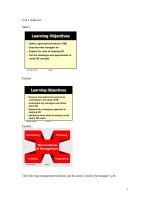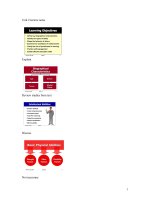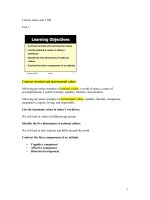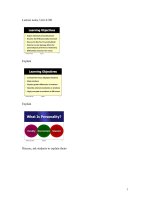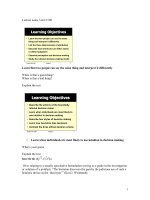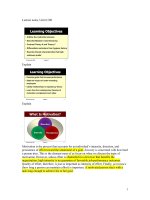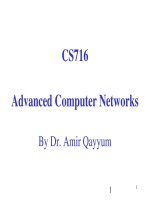Organizational behavior: Lecture 41 - Dr. Mukhtar Ahmed
Bạn đang xem bản rút gọn của tài liệu. Xem và tải ngay bản đầy đủ của tài liệu tại đây (1.76 MB, 68 trang )
Organizational
Behavior
(MGT-502)
Lecture-41
Today’s Topics
Review Part-III
Basic OB Model
Organization
systems level
Group
level
Individual
level
What are organizations?
• Social entities
• Goal oriented
• Deliberately structured
• Linked to the external environment
Characteristics Common
to All Organizations
Hierarchy of
authority
Division of
labor
Coordination
of effort
Common
goal
Organizations as Systems
Task environment:
Competitors
Unions
Regulatory agencies
Clients
Structure
Inputs:
Material
Capital
Human
Task
Technology
People
(Actors)
Organizational Boundary
Outputs:
Products
Services
Organization Structure: Its
Determinants and Outcomes
Causes
•Strategy
•Size
•Technology
•Environment
determines
Structural
designs
•Mechanistic
•Organic
Moderated by
Individual
Differences
leads to
Performance
and
Satisfaction
Chain of Command
• Chain of Command
– The unbroken line of authority that extends
from the top of the organization to the lowest
echelon and clarifies who reports to whom.
• Authority
– The rights inherent in a managerial position
to give orders and to expect the orders to be
obeyed
• Unity of Command
– Only one direct superior
Span of Control
The number of subordinates a
manger can efficiently and
effectively direct.
Organizational Level
Span of Control
Organization
Size
Strategy
Why Do
Structures
Differ?
Technology
Environment
Elements of Organizational
Structure
Departmentalization
Span of
Control
Organizational
Structure
Elements
Formalization
Centralization
Common
Organizational Design
•Simple Structure
•Bureaucracy
•Matrix Structure
The Distinguishing
Feature of Job Design in
the Future
Evolving Forms of
Organizational Design
• Several new forms of organizational
design
–Self-managing teams
–Team-based approach
–The virtual organization
Elements of the Environment
Technology
Political/Legal
The Organization
Sociocultural
Economic
Work Design and
Technology
Technology in the Workplace
• Continuous Improvement Processes
– Good isn’t good enough
– Focus is on constantly reducing the variability in
the organizational processes to produce more
uniform products and services.
• Lowers costs and raises quality.
• Increases customer satisfaction.
– Organizational impact
• Additional stress on employees to constantly excel.
• Requires constant change in organization.
Process Reengineering
Rethinking and redesigning the
processes by which the
organization creates value and
does work, ridding itself of
operations that have become
antiquated.
Work Space Design
• Size
– The trend is away from traditional allocation of space
based on organizational statue towards a flexible open
space design that accommodates group and team
activities.
• Arrangement
– Open arrangements foster social interaction and influence
the formality of relationships
• Privacy
– Individual employee needs for workplace privacy are
largely a function of the type of work that the employee
does (e.g., programmers, HR managers, receptionists).
Work Schedule Options
• Flextime: Employees work during a common
core time period each day but have discretion in
forming their total workday from a flexible set of
hours outside the core.
• Job Sharing: The practice of having two or
more people split a 40-hour-a-week job.
• Telecommuting: Employees do their work at
home on a computer that is linked to their
office.
Human Resource
Policies and
Practices
HRM Activities
• Getting people
• Preparing people
• Stimulating people
• Keeping people

